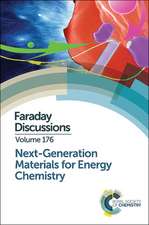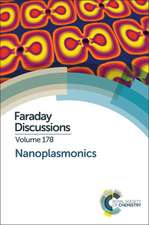Oxide Semiconductors for Solar Energy Conversion: Titanium Dioxide: Green Chemistry and Chemical Engineering
Autor Janusz Nowotnyen Limba Engleză Paperback – 30 mar 2017
The book provides a general background on oxide semiconductors based on binary oxides and their solid solutions, including electronic and ionic conductors. It covers several aspects of solid-state electrochemistry of oxides, such as defect chemistry, and defect-related properties, such as electrical properties, diffusion, segregation, and reactivity. The author also takes a pioneering approach in considering bulk versus surface semiconducting properties, showing how they are different due to the effect of segregation.
One of the first on semiconducting, photocatalytic, and photoelectrochemical properties of TiO2 and its solid solutions with donor- and acceptor-type ions, the book discusses defect chemistry of TiO2 in terms of defect equilibria and defect-related properties, including electrical properties, self and chemical diffusion, surface properties, segregation, and reactivity and photoreactivity with oxygen, water, and microbial agents. The text also illustrates the use of TiO2 as an emerging material for solar energy conversion systems, including the generation of hydrogen fuel by photoelectrochemical water splitting, the photocatalytic purification of water, and the generation of photovoltaic electricity. In addition, it presents defect disorder diagrams for the formation of TiO2-based semiconductors with controlled properties.
Encompassing the areas of solid-state science, surface chemistry, and photocatalysis, this book reflects the increasing awareness of the importance of structural imperfections, such as point defects, in understanding the properties of metal oxides, specifically TiO2-based semiconductors.
| Toate formatele și edițiile | Preț | Express |
|---|---|---|
| Paperback (1) | 700.75 lei 6-8 săpt. | |
| CRC Press – 30 mar 2017 | 700.75 lei 6-8 săpt. | |
| Hardback (1) | 2209.21 lei 6-8 săpt. | |
| CRC Press – 6 sep 2011 | 2209.21 lei 6-8 săpt. |
Din seria Green Chemistry and Chemical Engineering
- 18%
 Preț: 849.40 lei
Preț: 849.40 lei - 18%
 Preț: 1336.46 lei
Preț: 1336.46 lei - 28%
 Preț: 1430.10 lei
Preț: 1430.10 lei - 15%
 Preț: 651.72 lei
Preț: 651.72 lei - 18%
 Preț: 700.75 lei
Preț: 700.75 lei - 30%
 Preț: 1016.94 lei
Preț: 1016.94 lei - 9%
 Preț: 1347.52 lei
Preț: 1347.52 lei - 15%
 Preț: 508.10 lei
Preț: 508.10 lei - 31%
 Preț: 764.62 lei
Preț: 764.62 lei - 14%
 Preț: 1589.39 lei
Preț: 1589.39 lei - 18%
 Preț: 713.39 lei
Preț: 713.39 lei - 25%
 Preț: 496.94 lei
Preț: 496.94 lei - 18%
 Preț: 1590.61 lei
Preț: 1590.61 lei - 29%
 Preț: 1019.32 lei
Preț: 1019.32 lei - 30%
 Preț: 881.30 lei
Preț: 881.30 lei - 15%
 Preț: 459.74 lei
Preț: 459.74 lei - 18%
 Preț: 700.75 lei
Preț: 700.75 lei - 18%
 Preț: 700.75 lei
Preț: 700.75 lei - 15%
 Preț: 585.27 lei
Preț: 585.27 lei - 29%
 Preț: 524.78 lei
Preț: 524.78 lei -
 Preț: 463.30 lei
Preț: 463.30 lei - 15%
 Preț: 532.89 lei
Preț: 532.89 lei - 22%
 Preț: 370.25 lei
Preț: 370.25 lei - 18%
 Preț: 905.11 lei
Preț: 905.11 lei - 18%
 Preț: 1319.09 lei
Preț: 1319.09 lei - 18%
 Preț: 788.77 lei
Preț: 788.77 lei - 26%
 Preț: 1101.47 lei
Preț: 1101.47 lei
Preț: 700.75 lei
Preț vechi: 854.57 lei
-18% Nou
Puncte Express: 1051
Preț estimativ în valută:
134.09€ • 143.39$ • 111.80£
134.09€ • 143.39$ • 111.80£
Carte tipărită la comandă
Livrare economică 17 aprilie-01 mai
Preluare comenzi: 021 569.72.76
Specificații
ISBN-13: 9781138074873
ISBN-10: 113807487X
Pagini: 424
Ilustrații: 364 equations; 13 Tables, black and white; 291 Illustrations, black and white
Dimensiuni: 156 x 234 mm
Greutate: 0.45 kg
Ediția:1
Editura: CRC Press
Colecția CRC Press
Seria Green Chemistry and Chemical Engineering
ISBN-10: 113807487X
Pagini: 424
Ilustrații: 364 equations; 13 Tables, black and white; 291 Illustrations, black and white
Dimensiuni: 156 x 234 mm
Greutate: 0.45 kg
Ediția:1
Editura: CRC Press
Colecția CRC Press
Seria Green Chemistry and Chemical Engineering
Cuprins
Solid-State Electrochemistry of Binary Metal Oxides. Light-Induced Effects. Basic Properties of TiO2. Defect Chemistry. Electrical Properties. Diffusion. Effect of Interfaces. Applications. Appendix. Index.
Notă biografică
Janusz Nowotny is a professor of solar energy technologies at the University of Western Sydney. He has been a recipient of the Sir William Grove Award of the International Association for Hydrogen Energy and the Pfeil Award of the Institute of Materials, Minerals and Mining in London. Dr. Nowotny was the director of a NATO Advanced Research Workshop on Nonstoichiometric Compounds — Surfaces, Grain Boundaries and Structural Defects. He was also the founder and co-organizer of two series of International Workshops: Nonstoichiometric Compounds and Ceramic Interfaces.
Recenzii
… first comprehensive view on all the diverse properties of this material. … It is of invaluable importance for the entire materials science community. The book may be used as textbook for academic classes and researchers interested in the application of titania and titania-based materials. … The readers may find a wide range of materials data on mass and charge transport kinetics, segregation as well as a wide range of alternative defect-related properties of TiO2. Since assignable problems are given for each chapter, the book is also very useful for graduate classes in Materials Science and Engineering. It is a must for a wide community of researchers and developers.
—Werner Weppner, International Journal of Hydrogen Energy 37, 2012
The present book provides a comprehensive survey of defect chemistry and defect-related properties of oxides, including electronic structure, charge transport, diffusion, and segregation. … [This] book is probably the only survey on semiconducting and photocatalytic properties of TiO2 at present, particularly with respect to inclusion of the importance of defect chemistry. The research of the author in this area has attracted the prestigious award of the International Association for Hydrogen Energy. This book should be welcomed by the large research community interested in oxide semiconductors in general and TiO2 in particular, as well as the growing community interested in photocatalysis.
—Professor Eric D. Wachsman, University of Maryland
This book of Prof. Nowotny is addressing the increasingly urgent need for a treatise on oxide semiconductors in general and TiO2-based semiconductors in particular. … This book, which is the first extensive survey on the science of TiO2, will be of great help to the research community involved in the studies of the properties of TiO2.
—Professor Sebastian Fiechter, Helmholtz-Centre Berlin for Materials and Energy
—Werner Weppner, International Journal of Hydrogen Energy 37, 2012
The present book provides a comprehensive survey of defect chemistry and defect-related properties of oxides, including electronic structure, charge transport, diffusion, and segregation. … [This] book is probably the only survey on semiconducting and photocatalytic properties of TiO2 at present, particularly with respect to inclusion of the importance of defect chemistry. The research of the author in this area has attracted the prestigious award of the International Association for Hydrogen Energy. This book should be welcomed by the large research community interested in oxide semiconductors in general and TiO2 in particular, as well as the growing community interested in photocatalysis.
—Professor Eric D. Wachsman, University of Maryland
This book of Prof. Nowotny is addressing the increasingly urgent need for a treatise on oxide semiconductors in general and TiO2-based semiconductors in particular. … This book, which is the first extensive survey on the science of TiO2, will be of great help to the research community involved in the studies of the properties of TiO2.
—Professor Sebastian Fiechter, Helmholtz-Centre Berlin for Materials and Energy
Descriere
This book presents the first comprehensive survey of the properties and performance of TiO2-based semiconductors. It covers the use of defect engineering in the formation of novel oxide semiconductors with controlled properties. The author compares surface versus bulk semiconducting properties of oxide, outlines light measurements and light-induced properties, and describes a wide range of properties of TiO2 and its solid solutions. He also discusses the use of TiO2 in solar hydrogen fuel and solar water purification applications.


















